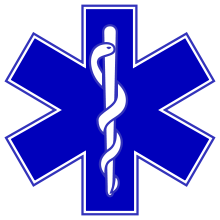- Medical Priority Dispatch System
-
The Medical Priority Dispatch System (MPDS) is a medically-approved, unified system used to dispatch appropriate aid to medical emergencies including systematized caller interrogation and pre-arrival instructions. Priority Dispatch Corporation is licensed to design and publish MPDS and its various products.
MPDS was developed by Dr. Jeff Clawson from 1976 to 1979. Dr. Clawson worked as an Emergency Medical Technician and dispatcher prior to medical school: he designed a set of standardized protocols to triage patients via the telephone and thus improve the emergency response system. Dr. Clawson states the main objective of MPDS is to "send the right thing to the right person in the right way at the right time." Cards were first alphabetized by chief complaint that included key questions to ask the caller, pre-arrival instructions, and dispatch priorities. After many revisions, these simple cards have evolved into MPDS.
MPDS today still starts with the dispatcher asking the caller key questions. These questions allow the dispatchers to categorize the call by chief complaint and set a determinant level ranging from A (Minor) to E (Immediately Life Threatening) relating to the severity of the patient's condition. Some systems also use the determinant O which may be a referral to another service or obvious death. Another sub-category code is used to further categorize the patient. For instance, a suspected cardiac or respiratory arrest where the patient is not breathing is given the MPDS code 9-E-1, whereas a superficial animal bite has the code 3-A-3. The MPDS codes allow emergency medical systems to determine the appropriate response mode (i.e. routine or "lights and sirens") and resources to be assigned to the event.
Contents
Dispatch Determinants
Each dispatch determinant is made up of three pieces of information, which builds the determinant in a Number-Letter-Number format. The first component, a number from 1 to 36, indicates a broad category or specific "Card" from the MPDS: the selection of this card is based on the initial questions asked by the emergency dispatcher. The second component, a letter A through E (including the Greek character Ω), is the response determinant indicating the potential severity of injury or illness based on information provided by the caller. The third and final component, a number, is the sub-determinant and provides more specific information about the patient's specific condition.
Cards
Card Category Card Category 1 Abdominal Pain/Problems 20 Heat/Cold Exposure 2 Allergic Reactions/Animal Stings/Envenomation 21 Hemorrhage/Lacerations 3 Animal Bites/Attacks 22 Inaccessible Incident/Entrapments 4 Assault/Sexual Assault 23 Overdose/Poisoning (Ingestion) 5 Back Pain (Non-Traumatic/Non-Recent) 24 Pregnancy/Childbirth/Miscarriage 6 Breathing Problems 25 Psychiatric/Suicide Attempt 7 Burns/Explosions 26 Sick Person 8 Carbon Monoxide/Inhalation/HazMat 27 Stab/Gunshot/Penetrating Trauma 9 Cardiac or Respiratory Arrest/Death 28 Stroke (C.V.A.) 10 Chest Pain 29 Traffic/Transportation Accidents 11 Choking 30 Traumatic Injuries 12 Convulsions/Seizures 31 Unconscious (Near) 13 Diabetic Problems 32 Unknown Problem (Man Down) 14 Drowning/Diving/SCUBA Accident 33 Inter-Facility Transfer/Palliative Care 15 Electrocution/Lightning 34 Automatic Crash Notification (A.C.N.) 16 Eye Problems/Injuries 35 HCP (Health-Care Practitioner) Referral 17 Falls 36 Flu-Like Symptoms (Possible H1N1) 18 Headache 37 Inter-Facility Transfer specific to medically-trained callers 19 Heart Problems/A.I.C.D. Card 36
This card was created to handle the influx of emergency calls during the H1N1 pandemic: it directed that Standard EMS Resources be delayed until patients could be assessed by a Flu Response Unit (FRU), a single provider that could attend a patient and determine what additional resources were required for patient care to reduce the risk of pandemic exposure to EMS Personnel.
Response Determinant
Letter Severity Resources Response Alpha Non Life-Threatening Basic Life Support Non Emergency Bravo Possibly Life-Threatening Basic Life Support Emergency Charlie Life-Threatening Advanced Life Support Emergency Delta Serious Life Threat Advanced Life Support Emergency Echo Life Status Questionable Closest Available (Multiple Resources Sent) Emergency Omega "Ω" Public Assist Only Basic Life Support Non Emergency References
- "Resources Emergency Priority Dispatch Systems". National Academies of Emergency Dispatch. http://www.emergencydispatch.org/ResourcesEDS. Retrieved 2011-02-07.
- "About Us". Priority Dispatch Corporation. http://www.prioritydispatch.net/index.php?a=company&e=about. Retrieved 2008-01-22.
- George, James; Quattrone, Madelyn (Fall 1991). "Above All-Do No Harm". Emergency Medical Technician Legal Bulletin 15 (4). http://www.emergencydispatch.org/articles/donoharm1.htm
Categories:- Emergency communication
- Emergency medicine
Wikimedia Foundation. 2010.

